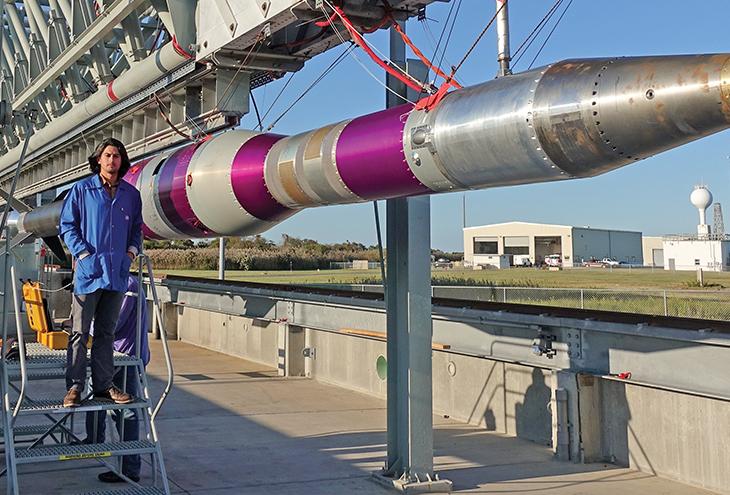At NASA’s Jet Propulsion Laboratory (JPL) in Pasadena, Calif., there’s something big happening. It’s called Mars 2020 — a mission to position NASA’s next Mars rover so it can investigate a region where the ancient environment may have been favorable to microbial life. Translation: the search for signs of life on the Red Planet is heating up.
For the rover to land successfully as it enters the Martian atmosphere, it will need a parachute that at the moment of full infl ation can go about twice the speed of sound and generate the nearly 70,000 pounds of drag force necessary to slow the payload. The high-level team dedicated to the project is known as ASPIRE: Advanced Supersonic Parachute Infl ation Research and Experiments.
The ASPIRE team member who’s in charge of comprehensive data-gathering instrumentation — and ensuring that the parachute will perform with precision — never expected to fi nd himself in the thick of the behind-the-scenes work for a mission to Mars. Meet Josef Sanchez, systems engineer. “As a kid, I never thought I would be able to work at a place like NASA and build rockets,” refl ects Sanchez. “It wasn’t until college that I really began to understand what engineers do.”
Those are humble words from a guy who was raised with two younger brothers by a working mom. He grew up “all over the place,” partly in California and partly in Mexico when staying with his father. “I was a small, shy kid, always focused on proving myself,” Sanchez explains. “We never had much money. I wanted to do well in school because I understood at a young age that education could change my situation.”
Looking back, there were some hints that aerospace engineering could be in Sanchez’s future. He inherited a love of building things from his father, a carpenter. And he shares an innate curiosity about how things work with his mother — a NASA fan who would point out “stuff like the aspects of certain soils that might make them capable of surviving on another planet.” And then there was a basic fact of Sanchez’s life that shaped his future. “Most of the things I had were broken,” he recalls, “which required learning how to fi x things.”
Sanchez applied his hard-earned ingenuity to working with his brothers and mother to build their fi rst computer. “When I was 11 or 12, my mom said, ‘There are six computers by a dumpster. Go get them — we can make a computer.’” It took a lot of trial and error, but the result was the computer that Sanchez used through his fi nal year of high school in Chula Vista, Calif.
His grades and test scores were good enough to get Sanchez into California Polytechnic State University in San Luis Obispo (Cal Poly), where he spent the next seven years working his way through college and earning both a bachelor’s and a master’s degree in aerospace engineering.
“As a kid, I never thought I would be able to work at a place like NASA and build rockets. It wasn’t until college that I really began to understand what engineers do.”
While taking a challenging course load, Sanchez held down at least one part-time job, including nighttime janitor at the student union. There were times he would wrap up his shift at 1:30 a.m., do homework until 3 a.m., get a little sleep, then start all over with a 7 a.m. class.
His perseverance paid off, as Sanchez was awarded several scholarships. Then came a real game changer: Sanchez was hired as a student technician for the Engineering Department. “It’s one of the most important things that happened while I was in school,” he says. In that role Sanchez was able to build confidence and experience while troubleshooting issues in the laboratories almost daily, right through grad school.
During his job search, Sanchez let potential employers know about his hands-on experience in Cal Poly’s labs. He was also able to tell them about his extracurricular involvement. “As soon as I got to Cal Poly, I found the Multicultural Engineering Program, which includes AISES,” recalls Sanchez, whose father is Mexican and whose mother is Mescalero Apache.
Sanchez was a College Chapter officer at Cal Poly, and currently participates in outreach efforts to AISES members for JPL, which he joined in 2013 after a stint as a test design engineer for a rocket and missile propulsion manufacturer. He was hired as a mechanical engineer and promoted to his current role a year later.
That small, shy kid is now part of something big. And he wants students with STEM ambitions to know that a career path like his is not only possible, but significant. “With our cultural perspective, we have a distinct and important voice,” he says. “We’re providing rare input. We can make an impact on how people learn and do things — that’s the point of engineering. I want Native students to know that in STEM, they’ll always have a voice.”













